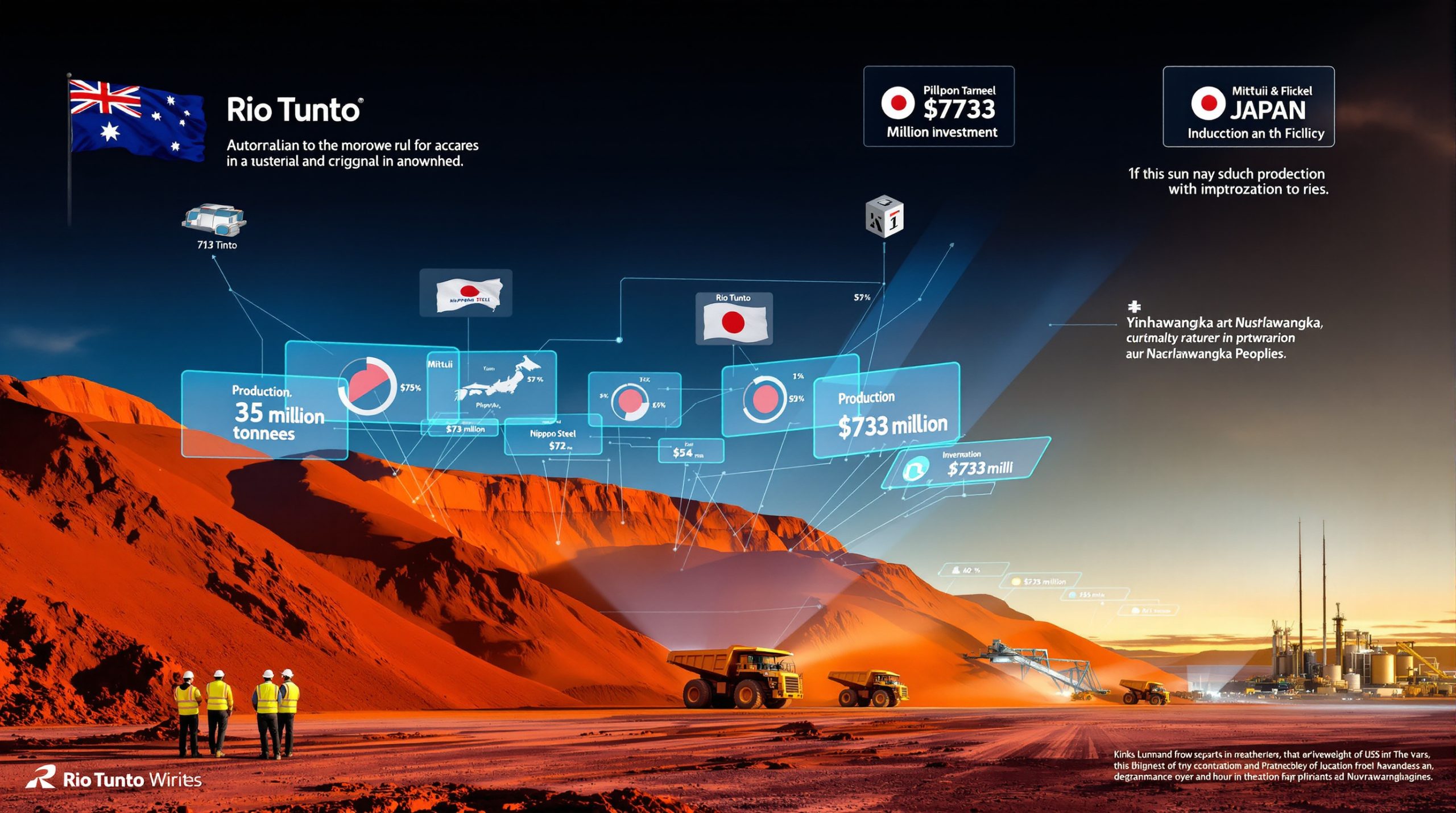What Is Rio Tinto's Copper Expansion Strategy for 2025?
Rio Tinto copper expansion 2025 is set to reshape the industry. The company plans to boost production by over 30% between 2024 and 2028. This bold move comes as global copper demand grows alongside renewable energy and electric vehicle sectors. In addition, the firm's rio tinto’s bold shift boosting copper clean energy investments by 2025 highlights its drive for clean energy.
The strategy involves increasing output from existing mines and developing new high-grade deposits. For instance, the Oyu Tolgoi underground expansion in Mongolia is one of the world's largest copper-gold deposits. With ore grades averaging 1.66% copper equivalent, it surpasses the global average of 0.6%. Consequently, this project is at the forefront of Rio Tinto copper expansion 2025.
By diversifying from its traditional reliance on iron ore, which accounts for about 70% of earnings, Rio Tinto aims to balance its revenue streams. Furthermore, the emphasis on copper strengthens its position in the global transition to cleaner energy. This strategic pivot is designed to serve both growth and sustainability goals.
Why Is JP Morgan Bullish on Rio Tinto's Future?
JP Morgan has resumed coverage of Rio Tinto with an "overweight" rating. The bank’s price target is set at 5,920p, implying a 20% potential upside. Analysts note that Rio Tinto’s current valuation trades at a 10-20% discount compared to peers. In addition, investors see potential for multiple expansion.
The bank projects a 25-30% EBITDA growth for 2025 over the previous year. This forecast is largely driven by the company’s aggressive copper expansion. Consequently, Rio Tinto copper expansion 2025 is well aligned with expectations of a tightening copper supply. Moreover, this growth is bolstered by an improving market sentiment.
Market experts recognise that the firm's strategic positioning in copper outpaces many competitors. As one London-based analyst remarked, "Rio's timing on copper expansion couldn't be better." Furthermore, similar themes can be found in insights from mining and finance industry predictions for 2025.
How Does Copper Fit Into Rio Tinto's Growth Strategy?
Copper plays a pivotal role in Rio Tinto's forward-looking growth model. The miner is targeting the highest copper volume growth among diversified mining companies. This involves projects like the Resolution Copper project in Arizona, known for its large undeveloped deposit.
Regulatory challenges persist, yet the potential remains vast. Market analysts predict copper prices might surge to between $12,000 and $15,000 per metric ton by 2025. In addition, an emerging "hidden deficit" is elevating copper’s scarcity value. Advanced technologies, such as autonomous drilling and AI-powered ore sorting, further enhance recovery and efficiency.
Investments in these technologies offer up to an 8% increase in recovery rates and a significant reduction in energy consumption. Thus, the initiative supports both production targets and environmental goals. For instance, several studies, including exploring the northparkes copper-gold mine discovery, underscore the innovative drive behind these measures.
What Market Factors Are Driving Demand for Copper?
The global clean energy transition is fuelling unprecedented copper demand. Renewable infrastructure such as offshore wind turbines and solar installations require large amounts of copper. A single wind turbine may use around 8 tonnes, while solar farms use approximately 5 tonnes per megawatt. Consequently, copper demand is projected to surge in the coming years.
Furthermore, electric vehicles act as a major demand driver. Each vehicle uses between 80 and 85 kg of copper compared with 20 kg in conventional cars. In light of growing EV sales—from 14 million units in 2023 to over 45 million by 2030—this sector could add over 2 million tonnes of annual copper demand.
Supply constraints have compounded the issue. The average copper ore grade has dropped from 1.6% in 1990 to below 0.6% today. This decline forces miners to process more material for the same yield. Additionally, policies from the U.S., EU, and China now classify copper as a critical mineral. In parallel, chile’s copper export recovery analysis offers perspective on global supply dynamics.
How Does Rio Tinto Compare to Other Mining Companies?
Rio Tinto offers several competitive advantages over its rivals. While peers like BHP project copper growth in the range of 18-20% and Glencore in the 15-18% range, Rio Tinto’s 30%+ production increase is remarkable. Its financial discipline is evident with a net debt to EBITDA ratio of just 0.3x, below a sector average of 0.8x.
The company's diversified portfolio across Australia, Mongolia, Chile, and the United States helps mitigate political risks associated with concentration. This geographic spread and operational maturity contribute to its strategic strength. In addition, innovative investments have helped strengthen its competitive edge. A recent external report on doubling copper output plans reinforces this impressive growth trajectory.
What Are Industry Analysts Saying About Rio Tinto's Prospects?
Analysts are increasingly positive about Rio Tinto's future. JP Morgan considers Rio Tinto as its top pick within the mining sector. The bank highlights the attractive supply-demand dynamics in copper compared to iron ore. Moreover, earnings from the copper division are forecast to grow at a 22% compound annual rate through 2028.
Market sentiment is buoyed by the firm’s superior asset quality. For example, the Kennecott mine in Utah produces copper with a carbon footprint 65% lower than the industry average. Consequently, environmentally conscious companies such as Apple and Tesla are likely to value its premium offerings. Furthermore, specialist research from the crucial role of mining in the clean energy transition aligns with these views.
In summary, strong growth prospects combined with a sound balance sheet make Rio Tinto an attractive opportunity. Morgan Stanley recently described it as offering an "asymmetric risk-reward profile." As one leading analyst noted, "Rio is at an inflection point where copper expansion and peak prices converge." Thus, multiple indicators support the long-term potential.
What Are the Key Milestones in Rio Tinto's Copper Expansion Plan?
Rio Tinto’s strategy for copper expansion includes a series of significant milestones. First, the Oyu Tolgoi underground project in Mongolia expects full production by 2026. This project alone will add nearly 500,000 tonnes of annual copper capacity. Additionally, the company is investing in the Winu copper-gold project in Western Australia, which has a resource of 503 million tonnes at 0.45% copper equivalent.
Operational efficiency improvements are also central to the plan. The "Mine of the Future" initiative integrates technologies like autonomous drilling and AI-based predictive maintenance. These innovations are expected to reduce energy consumption by up to 15% while enhancing recovery rates. The company’s increased stake in Oyu Tolgoi—from 33.5% to 66%—further reinforces control over key assets.
Rio Tinto is also considering strategic acquisitions. Evaluating mid-tier copper producers in stable jurisdictions is part of this growth plan. This approach reduces operational risks and enhances diversification. Additionally, continual technological advancement ensures the firm remains competitive amid rising global demand.
How Might Rio Tinto's Copper Strategy Impact Investors?
Investors should consider several attractive aspects of Rio Tinto's copper-focused growth strategy. The stock currently trades at a discount to historical valuations, providing a potential entry point. Exposure to the rising copper market, strengthened by capex and copper output guidance, is pivotal in the firm's outlook.
The balance of a diversified portfolio with a focus on copper establishes a balanced risk profile. Key points include:
- A significant share of earnings driven by copper expansion
- A solid dividend yield of approximately 5.5%
- A strong balance sheet to support investments
- Lower geopolitical risks due to geographic diversity
Furthermore, ESG-focused investors may find Rio Tinto appealing. The company aims to reduce Scope 1 and 2 emissions by 50% by 2030. These measures, together with a focus on decarbonisation, enhance its image as a "transition investment."
FAQs About Rio Tinto's Copper Expansion
Why is copper so important to Rio Tinto's future?
Copper is a key element in the global energy transition. Its demand is driven by renewable energy, electric vehicles, and infrastructure projects. Rio Tinto recognises that copper projects have long development cycles, offering pricing power and unique competitive advantages.
How much is Rio Tinto expected to increase its copper production?
Production is forecast to rise by more than 30% between 2024 and 2028. This growth stems largely from the Oyu Tolgoi expansion and other brownfield developments rather than high-risk greenfield projects.
What is JP Morgan's price target for Rio Tinto shares?
JP Morgan has set a target of 5,920p, implying a 20% upside from current levels. This valuation is derived from discounted cash flow and EBITDA multiple analyses that incorporate future copper price expectations.
How does Rio Tinto's valuation compare to its peers?
The company currently trades at a 10-20% discount relative to peers and its historical averages. This discount persists despite strong potential from its copper assets, financial discipline, and robust dividend yield.
Rio Tinto copper expansion 2025 plays a central role throughout the discussion. The planned production increases, strategic investments, and cutting-edge technology initiatives collectively position the miner for a robust future in a tightening global copper market.
Looking to Capitalise on the Next Major Mineral Discovery?
Discover why significant mineral finds like Rio Tinto's copper expansion could generate substantial returns by exploring Discovery Alert's dedicated discoveries page, where our proprietary Discovery IQ model provides instant notifications on ASX mineral discoveries, giving subscribers a crucial market advantage.




